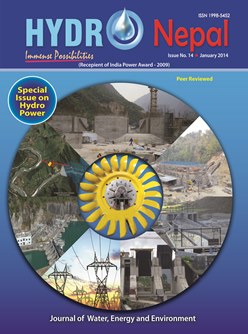Numerical Modeling of Nonuniform Flow in Settling Basins
DOI:
https://doi.org/10.3126/hn.v14i0.11251Keywords:
Settling basin, Trap efficiency, CFD, Hydropower, NepalAbstract
The settling basins for hydropower plants are designed to remove suspended sediments from the waterflow. The inlet geometry of the settling basin may cause formation of recirculation zones and high turbulence, which may lead to diminished trap efficiency, and as a consequence, turbine erosion. Most analytic approaches for calculating the trap efficiency of settling basins are based on the assumption of a uniform flow; hence, simplified one-dimensional equations are used to determine the velocity distribution and the turbulence characteristics of the flow. However, the velocity field in settling basins is often unevenly distributed, and the simplified equations are not always applicable. This study describes a new method for improving the assessment of settling basin performance. The idea is to extract values for the velocity distribution and the turbulence characteristics along the settling basins from computational fluid dynamic (CFD) models. The extracted CFD values are then used as input parameters to the standard analytical approaches for calculation of settling basin trap efficiency. This promising method is tested on a case study of a physical model of the settling basin for the Lower Manang Marsyangdi Hydropower Project in Nepal. The CFD calculations turn out to provide additional information to the sedimentation calculations in settling basins, and are useful for the assessment of different design alternatives at an early stage.
DOI: http://dx.doi.org/10.3126/hn.v14i0.11251
HYDRO Nepal Journal
Journal of Water, Energy and Environment
Volume: 14, 2014, January
Page: 27-35
Downloads
Downloads
Published
How to Cite
Issue
Section
License
The copyright of the articles and papers published is held by HYDRO Nepal Journal.
The views and interpretation in this journal are those of author(s), and HYDRO Nepal does not bear any responsibility for the views expressed by authors in the journal.




